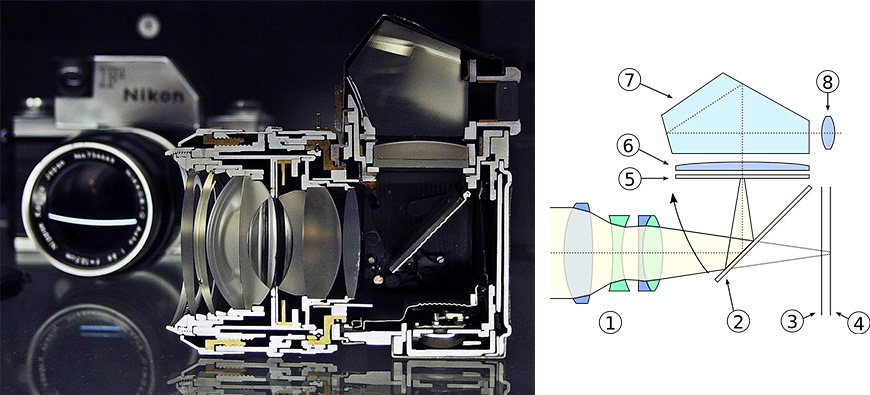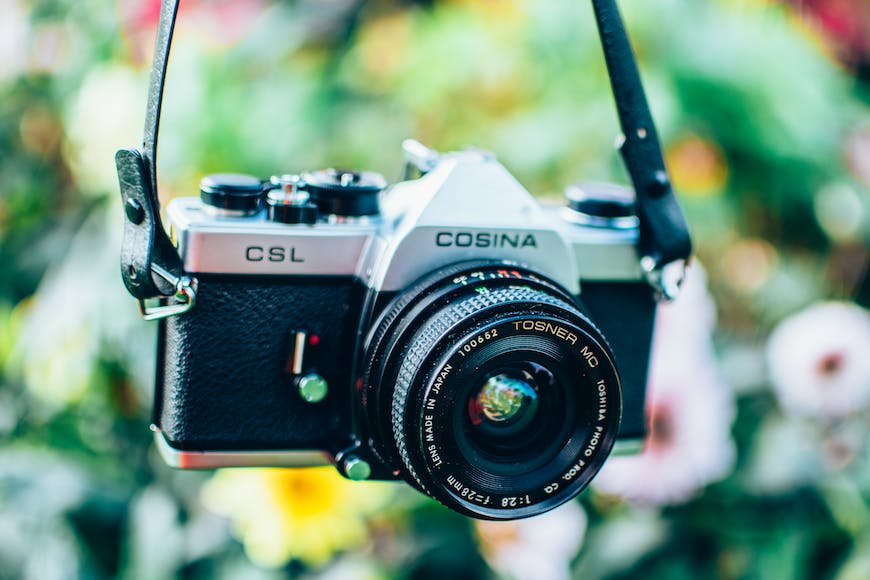
Are you wondering which camera is better – an SLR or a rangefinder?
This is a common question for people who want to shoot negative film. However, they both have a digital version as well.
Regardless of whether you’re shooting digital or film, you still need to decide which one is best for you.
So, let’s see how each camera works and what the pros and cons of their mechanisms are. This way, you can make an informed decision.
What Is the Difference Between an SLR and a Rangefinder?
If you’re comparing rangefinder vs SLR cameras, the main difference can be found in one place: through the lens.
Using an SLR camera, you can see through the lens. This refers to the composition, the field of view, the depth of field, etc.
Instead, the rangefinder’s viewfinder is separate – you can’t even see if the lens cap is on.
I know that when you say it like that, it makes you wonder why someone would even consider using a rangefinder camera.
However, there’s much more to it than that. So, let’s see the differences in more detail.
What Is an SLR?


Credit: Martin Vorel, CC BY-SA 4.0, Wikimedia Commons (left) / Cburnett, CC BY-SA 3.0, Wikimedia Commons (right)
SLR stands for Single Lens Reflex camera. The main characteristic of SLR cameras is that they have a reflex mirror system that allows you to see exactly what the lens is seeing in the viewfinder.
So, this is what happens inside the camera body when you use SLR film cameras.
When light goes through the lens, it hits a mirror that’s angled in such a way that the image bounces up towards a prism with five mirrors. This allows you to see through the viewfinder the same thing as the lens.
As a result, with SLR cameras, you can preview the exact framing, the depth of field, lens flares, etc.
Once you press the shutter button, the mirror raises so the light can pass through and hit the film for as long as the shutter is open.
When you’re taking a photograph and the mirror is up, you’ll see black through the viewfinder because the light isn’t bouncing up. After all, the mirror isn’t at the right angle.
Digital cameras with this system are called DSLRs. A DSLR works the same way as a film camera, except that there’s a digital sensor instead of the film.
I’ll explain the pros and cons of this mechanism later on in the article.
What Is a Rangefinder?
As the name says, a rangefinder camera is a photographic camera that uses a rangefinder mechanism to get the image in focus.
Most rangefinder cameras work with a split-image rangefinder.
Not all beginner photographers have heard about rangefinder cameras. However, you’ve probably heard of Leica because they are super high quality and used by famous street photographers.
Well, those Leica cameras are rangefinder cameras. While this brand has branched out in recent years, it’s mostly known for its rangefinder models.
Because these cameras use rangefinders, you don’t see through the lens. This is the main difference between rangefinder cameras and SLR cameras.
Rangefinder viewfinders are on the top left of the camera. This creates a parallax error, which becomes more evident with objects closer to the camera.
Another difference is the way you focus. Since you’re not seeing through the lens, you can’t see if the scene turns in and out of focus as you adjust it.
Instead, the rangefinder focus works by overlapping two images of the central fragment of the scene. Once both fragments are perfectly aligned, then your subject is in focus.
SLR vs Rangefinder: Pros and Cons
Now that you know the difference between SLR and rangefinder cameras, it’s time to understand the pros and cons of each system.
Let’s get to it.
Why Shoot With an SLR?


Credit: Lisa Fotios
- What you see is what you get.
- DOF preview feature.
- Faster shutter speeds.
- Autofocus availability.
- Lens versatility.
- Bigger and heavier.
- Louder.
- More camera shake.
- Viewfinder blockage.
SLR cameras are easier for beginner photographers to use. This is because what you see is what you get.
This makes it easier to compose your image, learn how to modify the depth of field using focal length and aperture, etc.
Speaking of aperture, an SLR camera normally has faster shutter speeds than a rangefinder camera. This gives you the possibility to get a shallower depth of field, even in bright scenarios, without requiring ND filters.
It’s also much easier to achieve perfectly sharp images – even when using manual focus. Also, most modern SLRs have an auto-focus feature.
On the other hand, SLR cameras are bigger and heavier because they have to host the mirror and the prism inside.
Also, when the mirror moves on an SLR, it makes more noise and is more susceptible to camera shake when you use slower shutter speeds.
For the same reason, you’ll have a viewfinder ‘blackout’ while taking a photo. If you’re using faster shutter speeds, this isn’t a big issue, but it may become one with slower speeds.
Now, let’s talk about lenses.
Single Lens Reflex camera models have interchangeable lenses, which isn’t a standard feature on rangefinder cameras. Because of this, SLR lenses are more available than rangefinder lenses.
Not only do you have a broader range of focal lengths, but you’ll also get a shorter focusing distance. This makes SLR cameras better to shoot macro photography.
Why Shoot With a Rangefinder?


Credit: Ronnie H
- You can see beyond the frame with most lenses.
- No blackout when shooting.
- No shutter lag.
- Smaller.
- Quiet shutters.
- Most affordable ones have fixed lenses.
- Fewer lens choices when they’re interchangeable.
- External viewfinder for wide-angle lenses.
- Only manual focus.
- You can only see the focus in a small patch.
As we’ve seen, you don’t see through the lens when you use rangefinder cameras. This gives the rangefinder some advantages.
The first and most valued by rangefinder users is the ability to see outside the frame. This is because the viewfinder of a rangefinder has a standard field of view – it may be 24mm, 28mm, or 35mm.
So, if you’re using a longer focal length, you’ll see frame lines indicating where the field of view of the lens actually is.
However, you can still see what happens around those frame lines. This way, you’ll be able to time your shot better to capture a moving subject or to prevent it from entering the frame – depending on what you need.
Speaking of perfect timing, you’ll also have a better shot of capturing the decisive moment because you don’t have a moving mirror. This means there’s no shutter lag or a viewfinder blackout.
Back to framing – I was telling you how using longer focal lengths gives you the advantage of seeing beyond the frame. But what if you’re using wide-angle lenses?
Well, then you’ll have a larger image than the one you see. To fix this problem, you must use an external viewfinder with a frame line that fits the desired focal length. These are usually attached to the hot shoe.
In the same way that wide angles can be an issue, telephoto lenses can also be problematic.
This is because when the lens is too long, it will get in the frame of your viewfinder, blocking the lower right corner of your view.
Most rangefinders have fixed lenses – so the problem is moot. But if you have a rangefinder camera with interchangeable lenses, do consider those things.
Also, remember that most rangefinder lenses are prime with manual focus – only a handful of zoom lenses are available on the market.
Another advantage of rangefinder cameras is that without the mirror slap, they’re quieter. They also allow you to work with slower shutter speeds without getting camera shake.
Also, the lack of a mirror allows the lens to be closer to the film plane, resulting in sharper images.
While we’re on the subject of sharpness, let’s talk about the bigger issue of the rangefinder cameras – the focusing.
Learning how to focus a rangefinder camera properly has a steeper learning curve. Unlike SLR cameras, you can’t see the image coming in and out of focus as you manually adjust it.
Instead, there’s a focusing patch in the center where you should find the perfect focus. While you do this, the rest of the scene looks the same, making it more difficult for beginners to get the perfect focus.
SLR vs Rangefinder vs Point and Shoot Film Cameras: Which Is Better for Street Photography?


Credit: Matheus Bertelli
We’ve already discussed the differences between the rangefinder vs SLR cameras – but what about the point-and-shoot?
Well, point-and-shoot cameras are compact, and they have a fixed lens – much like rangefinder cameras.
However, they have autofocus and auto exposure features that make them easier to use – in this case, more similar to SLR cameras.
So, are they better for street photography? Not necessarily.
First, if you’re considering a point-and-shoot camera, you’re probably set on using a film camera. If not, using a smartphone is probably better than a point-and-shoot.
This is because smartphones have become so important in everyday photography that manufacturers constantly improve them.
Instead, point-and-shoot cameras suffered a sales decline, meaning manufacturers weren’t interested in investing in new developments on affordable models.
So, for the same amount of money, you’ll get better quality pictures using a smartphone than a compact camera.
In any case, a rangefinder or an SLR camera, both digital and film, will give you more control and better results than a P&S.
Then, there’s the question of SLR vs rangefinder: which is best for street photography?
Many photographers agree that rangefinder is the best option for street photography because they’re quieter, compact and deliver sharper images.
Personally, I don’t think one is better than the other. They both have pros and cons – as we’ve seen. So, it’s a matter of which suits your style, needs, and skills better.
Slr vs Rangefinder FAQs
Is an SLR better than a rangefinder?
One isn’t better than the other – they’re simply different. Understanding the pros and cons of each one, you can decide which one is better for you.
What are the advantages of a rangefinder camera?
Rangefinder cameras don’t have a shutter lag or a blackout while shooting. Also, rangefinders are smaller, lighter and quieter.
What is the difference between rangefinder and point and shoot film?
Point-and-shoot cameras are designed for amateurs to get the best result with fewer skills required. As the name says, all the user needs to do is point and shoot.
Instead, the rangefinder requires more skills and gives you more control over the final image.
Is a rangefinder better than a mirrorless camera for street photography?
Mirrorless cameras take care of the SLR’s previous disadvantages of noise, shutter blackout, and shutter lag. However, they’re still bigger than digital rangefinders in most cases. However, they do have a wider variety of lenses.
Ultimately, it comes down to a matter of taste and, in this case, budget. There aren’t many digital rangefinders – the ones on the market can be pretty pricey. Instead, an entry-level DSLR mirrorless is much more affordable.






